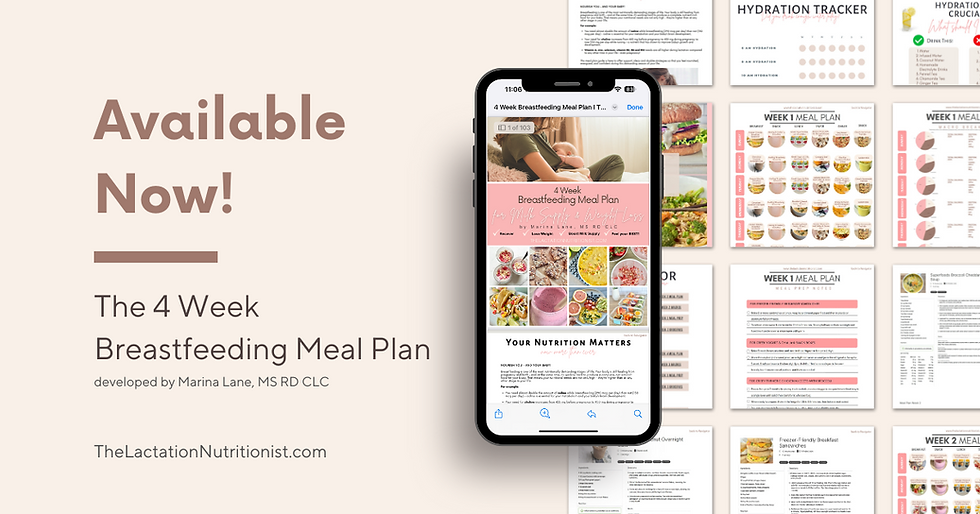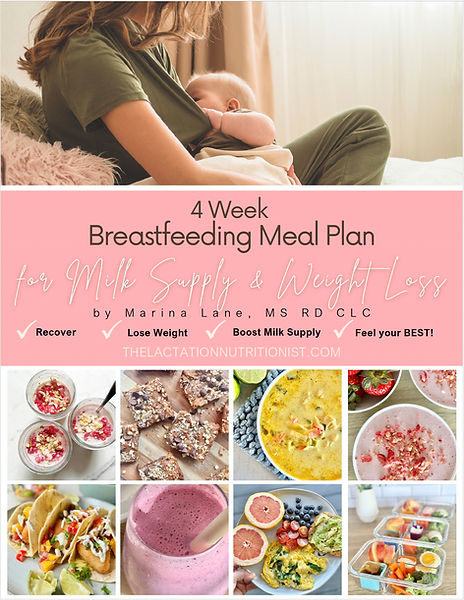
Breastfeeding Meal Plan - A 4-Week Guide for Milk Supply & Postpartum Weight Loss
Created by a Registered Dietitian & Certified Lactation Counselor to nourish you, protect your milk supply, and support gentle postpartum recovery.
-
Designed for Breastfeeding & Postpartum
-
2200 to 2400 calories per day to meet postpartum needs
-
Balanced Macros to promote gradual weight loss
-
Quick, easy, family-friendly recipes
-
Developed & tested by a Registered Dietitian
-
No AI created recipes or photos!
-
Lose weight - without losing your milk supply
Why This Meal Plan Works for Breastfeeding Moms
This plan was developed by an expert in postpartum nutrition & recovery - Registered Dietitian, Lactation Counselor and mom of 2 Marina Lane, MS RD CLC.
Every recipe has been tested, every meal thoughtfully created and macros were balanced to support energy, recovery, and milk optimization - without unnecessary stress or fancy ingredients.
Plus: Guaranteed no AI-generated recipes or stock photos were used - which is something I commonly see with other meal plans.
I (a Registered Dietitian, Lactation Counselor and mom of 2) personally made, tested and took photos of every single recipe in this meal plan - which means it will actually turn out and taste good!
What's Included in the 4-Week Breastfeeding Meal Plan:
-
Daily meals & snacks (Breakfast, Lunch, Dinner + Snacks for 4 weeks)
-
Over 60 easy recipes curated for postpartum nutrition
-
Balanced meals that promote hormone balance, recovery, and milk optimization
-
Built-in leftovers and meal prep recipes to reduce cooking
-
Grocery lists by week, sorted by aisle
-
Meal prep tips to help you stay ahead
-
Hydration Tips & Tracker
-
Real food, no weird ingredients, and zero calorie counting!
-
4 FREE Bonuses (see below)
BONUS #1
-
The Lactation Superfoods Guide - Superfoods for Postpartum Recovery & Breastfeeding
BONUS #2
-
The Mocktail Guide for Pregnancy & Breastfeeding - Explore delicious recipes like the creamy Virgin Piña Colada, the Watermelon Mint Refresher, and the antioxidant-rich Berry Mojito. - all 100% alcohol free
BONUS #3
-
The Postpartum Freezer Meals Guide - Kickstart your Postpartum Journey with this essential guide to prepping and storing freezer meals.
BONUS #4
-
30 Day FREE access to the TLNourish Postpartum Nutrition App - a postpartum (& beyond) nutrition app designed specifically for moms like YOU! Find out more about the app by clicking here.

How This Plan Supports Milk Supply & Postpartum Weight Loss
Your body has a unique challenge in the postpartum period: you need enough calories and nutrients to keep up your milk supply - while also wanting to feel like yourself again and maybe lose the baby weight. Most generic “diet” plans either:
-
Cut calories too drastically (risking your supply), or
-
Overlook your higher nutritional needs as a breastfeeding mom.
This plan strikes the balance.
For Milk Supply:
-
Provides ~2200 - 2400 calories per day (the sweet spot for most breastfeeding moms).
-
Includes milk-boosting foods like oats, flax, nuts, seeds, lentils, and leafy greens.
-
Focuses on hydration-rich meals and snacks to support fluid needs.
For Postpartum Weight Loss:
-
Emphasizes balanced meals with protein, fiber, and healthy fats to keep you full and stabilize blood sugar.
-
Avoids fad diets, extreme restrictions, or unsafe supplements.
-
Uses smart meal prep strategies so you’re never skipping meals or grabbing low-nutrient “quick fixes.”
-
Creates a gentle calorie deficit over time to promote steady, sustainable weight loss - without compromising supply.
👉 The result: more energy, a healthy milk supply, and gradual weight loss that supports long-term recovery.
The Plan That Helped Me Lose 40+ lbs - without losing my milk supply
These are the exact types of meals and macros I used to lose all my "baby weight" - without ever stepping foot in a gym, taking questionable supplements, or developing stretch marks. By focusing on nutrient-dense, balanced meals that support hormone health, nutrient recovery and

balanced blood sugars, I was able to nourish my body, maintain my milk supply, and gently lose weight in a way that felt natural and sustainable. No extremes, no restrictions - just real food that works with your body, not against it.

What Other Moms Are Saying





FAQ
FAQ 1: Can I safely lose weight while breastfeeding?
Yes - but slowly is best. Your body burns extra calories making milk, so most moms need about 2200–2400 calories a day to maintain supply (find out your calorie needs using my Breastfeeding Calorie Calculator). A drastic calorie cut can lower milk production, increase fatigue and slow down your metabolism. This plan is designed to keep your supply strong while gently supporting weight loss with balanced, satisfying meals.
FAQ 2: How many calories should I eat while breastfeeding?
Believe it or not, exclusively breastfeeding burns around 500 to 670 calories per day - that's about as many calories as you'd burn going on a 45 minute run! Let's say your daily calorie needs (calculated using your height, weight, activity level and age) is around 2000 calories per day - that means you'd need 2500 to 2670 calories per day to maintain your weight and milk supply while breastfeeding. A moderate calorie restriction of about 300 calories per day will help you lose weight without losing your milk supply. More info on this topic a well as sources can be found can be found on my blog post, "How Many Calories Does Breastfeeding Burn?".
FAQ 3: Why am I not losing weight while breastfeeding?
It's a common frustration - many moms are told that "the weight will just fall off" while breastfeeding. In reality, it doesn't always work that way, and there are good reasons why. Breastfeeding hormones like prolactin can increase appetite and change the way your body stores fat. Some studies suggest that women may hold onto 2 to 5 extra pounds of fat during lactation as a protective mechanism for milk supply. Some moms also have a hard time finding the perfect 'calorie range' that promotes gradual weight loss while protecting mom's metabolism and milk supply. Sleep deprivation and raised cortisol (stress hormone) levels can also sabotage weight loss efforts as hormonal imbalances tend to push the body towards storing fat, especially around the midsection. The right meal plan can help get you on the right calorie track, balance your hormones, and reduce stress to promote safe, sustainable weight loss while breastfeeding.
FAQ 4: What foods boost milk supply?
While effective milk extraction and a good latch are key to a healthy milk supply, some foods have traditionally been used to support milk production, and a few are backed by emerging research. While results vary from mom to mom, here are four that may help - and they’re all included in this breastfeeding meal plan:
-
Oats: Oats are one of the most popular lactation foods. They’re rich in iron, fiber, and beta-glucans, which may stimulate prolactin (the hormone that drives milk production). Moms with low iron levels may especially benefit from including oats regularly.
-
Flaxseeds: Flaxseeds are high in omega-3 fats and plant-based phytoestrogens (lignans). These compounds may influence milk production by mimicking estrogen and supporting hormone balance. Ground flax is easy to add into smoothies, oatmeal, or baked goods.
-
Ginger: Ginger has been studied in the postpartum period and one small clinical trial found that mothers who took ginger supplements early after birth had higher milk volumes compared to those who didn’t. More research is needed, but ginger tea or adding fresh ginger to meals is a safe and nourishing option.
-
Garlic: Garlic has long been used in traditional cultures as a galactagogue. Interestingly, studies show that when moms eat garlic, babies may nurse longer because they’re attracted to the flavor in breast milk. This increased feeding frequency can, in turn, help stimulate supply.
👉 While no food is a guaranteed milk-booster, these ingredients are nutrient-dense, safe, and beneficial for postpartum recovery. Including them regularly can help support both your overall health and your breastfeeding journey. → Learn more about foods that increase milk supply.
FAQ 5: What foods should I avoid while breastfeeding?
Most moms don’t need to follow a restrictive diet while breastfeeding. Yes, even spicy foods, citrus fruits and gassy foods are ok to eat for most moms. There are only a few foods and substances I recommend to avoid (or limit) while breastfeeding:
-
High-mercury fish: Fish is a great source of protein and DHA, but some species (shark, swordfish, king mackerel, tilefish) contain high levels of mercury, which can pass into breast milk. Safer options include salmon, sardines, trout, and cod.
-
Artificial Sweeteners: Non-nutritive sweeteners like aspartame, saccharin, and sucralose are a no-go in my book. More and more studies have come out over the past years showing a negative impact on the gastrointestinal system, neurological development and chronic disease risk. I recommend minimizing them when possible and choosing natural sweeteners like fruit, dates, or small amounts of honey instead.
-
Caffeine: Small amounts are safe, but high intakes can make some babies fussy or disrupt sleep. The general recommendation is to keep it under 200 - 300 mg per day (about 1 - 2 cups of coffee).
-
Alcohol: Occasional alcohol can be compatible with breastfeeding if timed carefully, but excess use is not recommended. Alcohol passes into milk at the same level as in your blood. → Learn more about alcohol and breastfeeding safety.
-
Foods that seem to upset baby: Some babies may be more sensitive to cow’s milk protein, soy, or very spicy foods. There’s no need to avoid these unless you notice a clear pattern. → Learn more about foods to avoid while breastfeeding.
FAQ 2: Which foods help with postpartum recovery?
Your body is doing double duty in the postpartum period - healing from birth while also producing milk. Certain foods can make that recovery smoother:
-
Protein-rich foods (chicken, eggs, lentils, Greek yogurt) - Support tissue repair, wound healing, and hormone balance.
-
Iron-rich foods (beef, poultry, beans, spinach) – Rebuild blood stores lost during delivery and prevent anemia. Pair with vitamin C foods (citrus, bell peppers) for better absorption.
-
Healthy fats (salmon, avocado, nuts, flaxseeds) – Provide omega-3s for brain health, hormone production, and reducing inflammation.
-
Whole grains (oats, quinoa, brown rice) – Give sustained energy and contain fiber to ease postpartum digestion.
-
Leafy greens & colorful vegetables – Supply calcium, folate, antioxidants, and vitamins to reduce inflammation and support overall recovery.
-
Hydrating foods & fluids (soups, smoothies, water-rich fruits) – Replace the fluids lost through birth and breastfeeding.
👉 This meal plan is built around these nutrient-dense foods to help your body heal, restore energy, and keep your milk supply strong all while being practical for busy moms.

.png)
